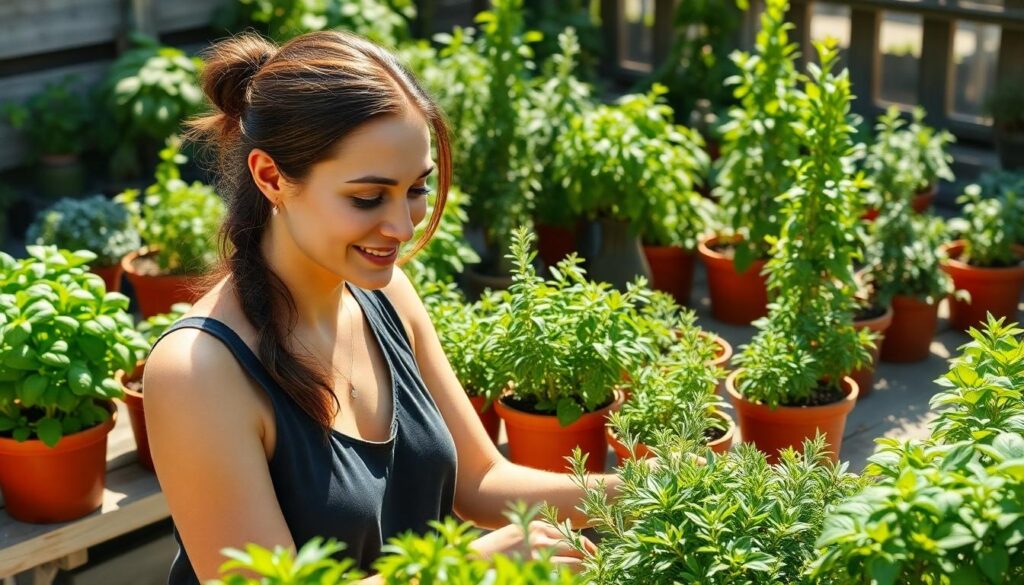Growing your own herb garden isn’t just a hobby—it’s a gateway to fresher meals, aromatherapy, and sustainable living. We’ve discovered that nothing compares to the satisfaction of snipping fresh basil or mint straight from your own plants when cooking. Whether you’re working with a spacious backyard or a tiny apartment windowsill, herb gardens adapt to any living situation.
We’ll show you how easy it is to start your herb garden journey, even if you’ve never grown anything before. From selecting the right herbs for your cooking style to understanding basic care requirements, this guide covers everything you need. The beauty of herb gardening lies in its simplicity and immediate rewards—most herbs grow quickly and provide months of harvests with minimal maintenance.
7 Essential Herbs to Start Your Herb Garden
1. Basil
Basil stands as the cornerstone of any herb garden with its aromatic leaves and versatile culinary uses. This sun-loving annual thrives in warm conditions and grows quickly from seed or starter plants. Fresh basil elevates countless dishes from Italian classics like pasta and pizza to Thai curries and refreshing summer salads. Growing basil requires well-draining soil, regular watering, and frequent harvesting to encourage bushy growth. Pinch off flower buds as they appear to extend the harvest season and prevent the leaves from becoming bitter.
2. Rosemary
Rosemary brings a woody, pine-like fragrance and robust flavor to your herb collection. This perennial Mediterranean shrub can live for years when properly cared for, making it an excellent investment for your garden. Hardy rosemary tolerates drought conditions once established and prefers full sun with excellent drainage. Use its needle-like leaves to enhance roasted meats, potatoes, breads, and infused oils. Rosemary also works beautifully in container gardens and can even be trained into decorative topiary forms for dual aesthetic and culinary purposes.
3. Mint
Mint grows with incredible vigor and provides refreshing flavor for both culinary and beverage applications. This prolific herb spreads rapidly through underground runners, so we recommend planting it in containers to prevent garden takeovers. Spearmint and peppermint varieties offer distinctly different flavor profiles worth exploring. Fresh mint leaves brighten summer drinks, desserts, and Mediterranean dishes, while also making excellent teas. Mint thrives in partial shade and appreciates consistent moisture, rewarding even novice gardeners with abundant harvests.
4. Parsley
Parsley delivers bright, fresh flavor and serves as both a garnish and key ingredient in countless recipes. This biennial herb comes in flat-leaf (Italian) and curly varieties, with flat-leaf typically offering stronger flavor for cooking. Growing parsley requires patience as seeds germinate slowly, but once established, it produces abundantly for months. Plant parsley in rich, moist soil with partial to full sun exposure. Harvest the outer stems first by cutting them at the base to encourage continuous new growth from the center of the plant.
5. Thyme
Thyme offers incredible versatility with its tiny, aromatic leaves that enhance nearly any savory dish. This low-growing perennial herb forms attractive mounds and works well in containers, gardens, or as border plantings. Common thyme, lemon thyme, and creeping thyme varieties each provide unique flavors worth exploring. Growing thyme requires minimal effort as it thrives in average to poor soil with excellent drainage and full sun. The plant’s drought tolerance makes it perfect for busy gardeners, while its compact growth habit suits small spaces beautifully.
6. Chives
Chives bring mild onion flavor and attractive purple blossoms to your herb garden. These hardy perennials return reliably year after year, forming clumps that gradually increase in size. Fresh chive stems can be snipped with scissors directly into dishes like omelets, baked potatoes, soups, and salads. Growing chives requires minimal maintenance beyond occasional watering and dividing crowded clumps every few years. Plant them in containers or garden beds with moderately rich soil and at least 6 hours of sunlight daily for best production.
7. Cilantro
Cilantro delivers distinctive flavor that forms the backbone of many Mexican, Indian, and Southeast Asian cuisines. This quick-growing annual herb produces flavorful leaves followed by coriander seeds if allowed to flower. Fresh cilantro leaves brighten salsas, curries, and countless dishes with their unique taste. Growing cilantro works best in cooler weather as it tends to bolt (go to seed) quickly in heat. Succession planting every few weeks ensures continuous harvests, while selecting slow-bolt varieties extends the growing season. Provide moderate water and harvest regularly by cutting the outer stems at their base.
How to Choose the Perfect Location for Your Herb Garden
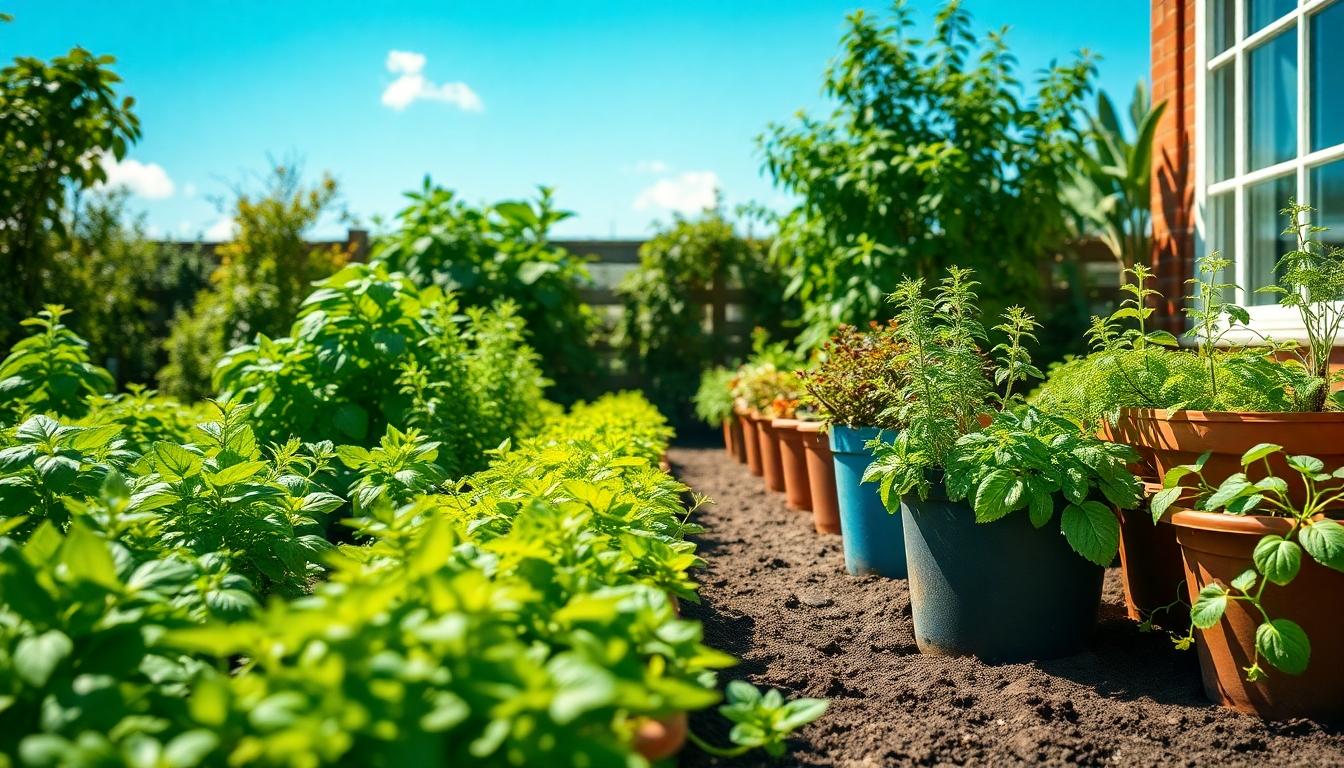
When planning your herb garden, selecting the right location is crucial for success. The perfect spot will ensure your herbs thrive and provide abundant harvests throughout the growing season.
Indoor vs. Outdoor Considerations
Deciding between an indoor or outdoor herb garden depends on several factors that directly impact your herbs’ growth:
- Outdoor Gardens provide ideal conditions for most herbs as they naturally receive ample sunlight. For optimal growth, position your outdoor herb garden where it gets at least six to eight hours of direct sunlight daily. Remember to choose a location that offers protection from harsh weather elements like strong winds and heavy downpours to prevent damage to your delicate herbs.
- Indoor Gardens work well for herbs that can tolerate partial shade conditions. South or southwest-facing windows offer the best light exposure for indoor herb gardens. North-facing windows can accommodate shade-tolerant varieties like parsley and mint, which require a minimum of four hours of sunlight per day. Indoor gardens also provide the advantage of year-round growing regardless of outside weather conditions.
Sunlight Requirements for Different Herbs
Understanding each herb’s exact light needs will help you arrange your garden efficiently:
- Full Sun Lovers include most popular culinary herbs such as basil, rosemary, sage, and thyme. These sun-worshippers need at least six to eight hours of direct sunlight daily to develop their full flavor profiles and aromatic qualities. Without adequate sunlight, these herbs may become leggy, pale, and less flavorful.
- Partial Shade Performers include mint, parsley, cilantro, and chives. These more adaptable herbs can thrive with less direct sunlight, typically requiring four to six hours daily. Placing these herbs in areas that receive morning sun and afternoon shade often creates ideal growing conditions, especially in warmer climates where afternoon sun can be intense.
If your garden space has limited sunlight, consider using containers for your herbs. Container gardening offers the flexibility to move your plants throughout the day to capture available sunlight. Also, different herbs have varying soil preferences—mint adapts to almost any soil condition, while others may need more exact growing media for best results.
Selecting the Right Containers for Your Herb Garden
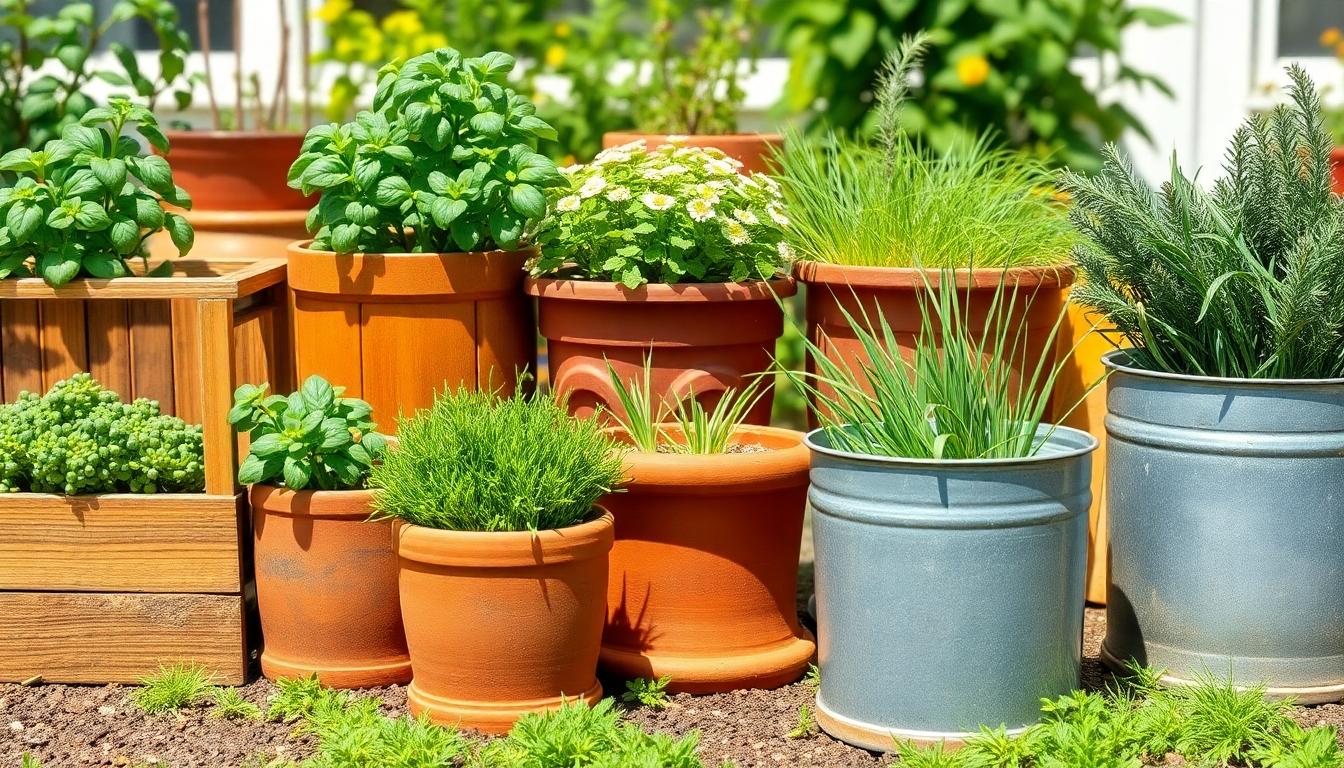
Choosing the right containers is crucial for creating a thriving herb garden. The proper pots will ensure your herbs have adequate space to grow and proper drainage to prevent root diseases.
Container Materials and Drainage Options
When selecting containers for your herb garden, natural, food-grade materials should be your top priority. Cedar planters, untreated steel containers, and terra cotta clay pots create ideal organic growing conditions for your culinary herbs. These materials allow proper air circulation and moisture balance that herbs need to flourish. Avoid using containers treated with chemicals or non-porous synthetic materials as they can suffocate roots and potentially leach unwanted substances into your edible plants.
Proper drainage is essential for healthy herb growth. Your containers need 3-4 inches between drainage holes at the base to prevent waterlogging that can lead to root rot. If your chosen containers don’t have pre-made holes, use a drill to create adequate drainage points. Adding a layer of weed barrier cloth, industry fabric, or burlap at the container’s bottom helps retain soil during watering while still allowing excess moisture to escape.
For soil, we recommend using a specialized blend of topsoil, compost, and coarse sand (such as paver sand) to create optimal drainage and nutrient retention. Adding earthworm castings to this mixture provides additional nourishment that will help your herbs thrive throughout the growing season.
Size Requirements for Different Herbs
Matching container size to your exact herbs ensures they have adequate space to develop healthy root systems. Small herbs like chives and thyme thrive in 6-8 inch diameter containers, making them perfect for windowsills or small spaces. These compact herbs can also be grouped together in wider planters such as the EarthBox Junior system to create an efficient herb garden.
Medium-sized herbs including basil and parsley require more substantial root space. These popular culinary herbs need 8-10 inch pots with 6-8 inch depth to allow proper root expansion and development. This extra space ensures they can produce abundant leaves for regular harvesting throughout the season.
Larger herbs such as rosemary demand significantly more space due to their extensive root systems. These woody perennial herbs need 10-12 inch diameter containers with at least 12 inches of depth to accommodate their growth. Providing adequate space for these larger herbs prevents them from becoming root-bound and ensures years of productive growth.
Indoor herb gardens on windowsills require minimum 4-inch pots for proper development. Though compact, these containers can successfully support many culinary herbs when proper care is provided. The right container size allows your herbs to establish strong roots while fitting perfectly in your available space.
Best Soil Mixtures for a Thriving Herb Garden
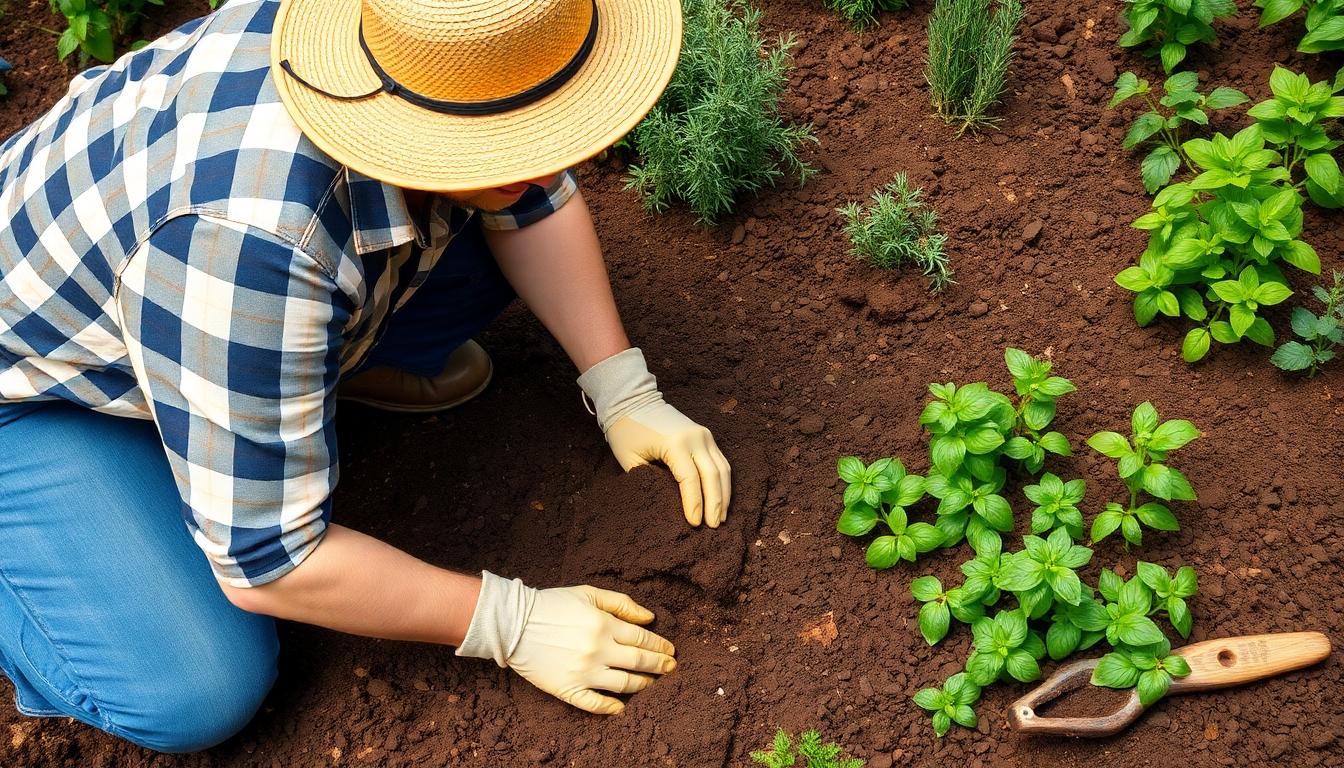
Creating the perfect soil environment is crucial for your herb garden’s success. Herbs thrive in well-draining, nutrient-rich soil with a sandy-loam texture that balances drainage and moisture retention.
Creating the Ideal Soil Base
The foundation of a thriving herb garden starts with proper soil composition. Most herbs prefer a well-draining soil mixture that combines sand, silt, and clay in optimal proportions. For container gardens, use all-purpose potting soil as your base rather than specialty mixes designed for exact plants. Enhance this base by adding amendments like perlite, coarse sand, or compost to improve structure and drainage capabilities.
Try this DIY herb garden soil blend for excellent results:
- 1/3 compost for rich organic matter
- 1/4 coarse sand for improved drainage
- 2 cups perlite to prevent compaction
- Small amount of organic fertilizer for sustained nutrition
Gardenary’s popular “103 Mix” offers another proven formula, combining topsoil, quality compost, and sand with additional nutrients for optimal herb growth. This mixture supports healthy root development while providing the drainage Mediterranean herbs particularly require.
Organic Soil Amendments
Boost your herb garden’s fertility naturally with organic amendments that improve soil structure and nutrient availability. Compost stands out as the most versatile amendment, increasing organic matter content while promoting beneficial microbial activity in your soil. For container herbs, mycorrhizae inoculants significantly improve root systems’ ability to absorb nutrients from the soil.
When seeking amendments that release nutrients gradually, aged manure and worm castings offer excellent options that won’t overwhelm sensitive herb roots. Coconut coir makes an exceptional addition to porous soil mixtures, improving moisture retention without creating waterlogged conditions that herbs detest. These organic materials create living soil that continually nourishes your herbs while maintaining proper structure.
pH Balance for Herb Gardens
Most culinary herbs flourish in slightly acidic to neutral soil with pH levels between 6 and 7. Certain herbs have exact preferences, with parsley and sage tolerating more alkaline conditions while dill prefers slightly acidic environments. Testing your soil annually with a simple home pH kit provides valuable information about necessary adjustments.
For chalky soils measuring above pH 8.5, add substantial compost to moderate alkalinity or consider creating raised beds filled with properly balanced loam. Acidic soils benefit from lime applications, while overly alkaline soils can be balanced with sulfur amendments. Sandy-loam or loam soils generally maintain ideal pH levels naturally, making them adaptable to most herb varieties without extensive modification.
Key Soil Considerations
Drainage remains absolutely critical for Mediterranean herbs like rosemary and lavender, which originated in dry, rocky conditions. Use containers with adequate drainage holes and raised feet to prevent water pooling beneath pots. Container herbs grow best in peat-free vegetable mix, particularly nutrient-demanding varieties like basil, though standard potting soil works well for most herb types.
Apply nutrients moderately since herbs generally require fewer fertilizers than vegetables. Excessive feeding often reduces flavor intensity and essential oil production in culinary herbs. Focus instead on creating balanced soil structure that allows roots to access available nutrients efficiently while maintaining proper moisture levels for consistent growth.
Watering Techniques for Your Herb Garden

Proper watering is crucial for a thriving herb garden. Most herbs require consistent but measured watering, typically once or twice weekly depending on your local climate conditions. We recommend allowing the soil to dry slightly between waterings to prevent root issues.
For container herbs, check for adequate drainage holes and water until you see excess flowing out the bottom. These potted plants dry out faster than in-ground herbs and may need daily watering during hot weather. To determine if your herbs need water, insert your finger about half an inch into the soil—if it feels dry at that depth, it’s time to water.
Seasonal Watering Adjustments
Summer months demand more attentive watering practices for your herb garden. During hot weather, herbs may require watering twice weekly as evaporation increases and plants use more moisture for cooling. Container herbs are particularly vulnerable to heat stress and might need daily watering during intense summer periods.
Winter brings different watering challenges for herb gardens. As growth slows during cooler months, herbs need significantly less water. We recommend reducing your watering frequency and amount to match the decreased metabolic activity of your plants. Always monitor soil moisture rather than following a strict schedule, as indoor heating can sometimes create unexpected dry conditions.
Signs of Overwatering and Underwatering
Recognizing water stress symptoms helps maintain healthy herbs. Overwatered herbs typically develop yellowing leaves that feel soft or soggy to the touch. Root rot may appear as darkened, mushy roots with an unpleasant smell. Plants might show stunted growth even though frequent watering, and fungal issues like powdery mildew may develop on leaf surfaces.
Underwatered herbs display different warning signs that shouldn’t be ignored. Wilting leaves, even in cooler temperatures, indicate insufficient moisture. Dry, crispy leaf edges, stunted or halted growth, and soil pulling away from container edges are clear signals that your herbs are thirsty. Monitoring these symptoms and adjusting your watering routine accordingly ensures your herb garden remains productive throughout all seasons.
Harvesting and Preserving Herbs from Your Garden
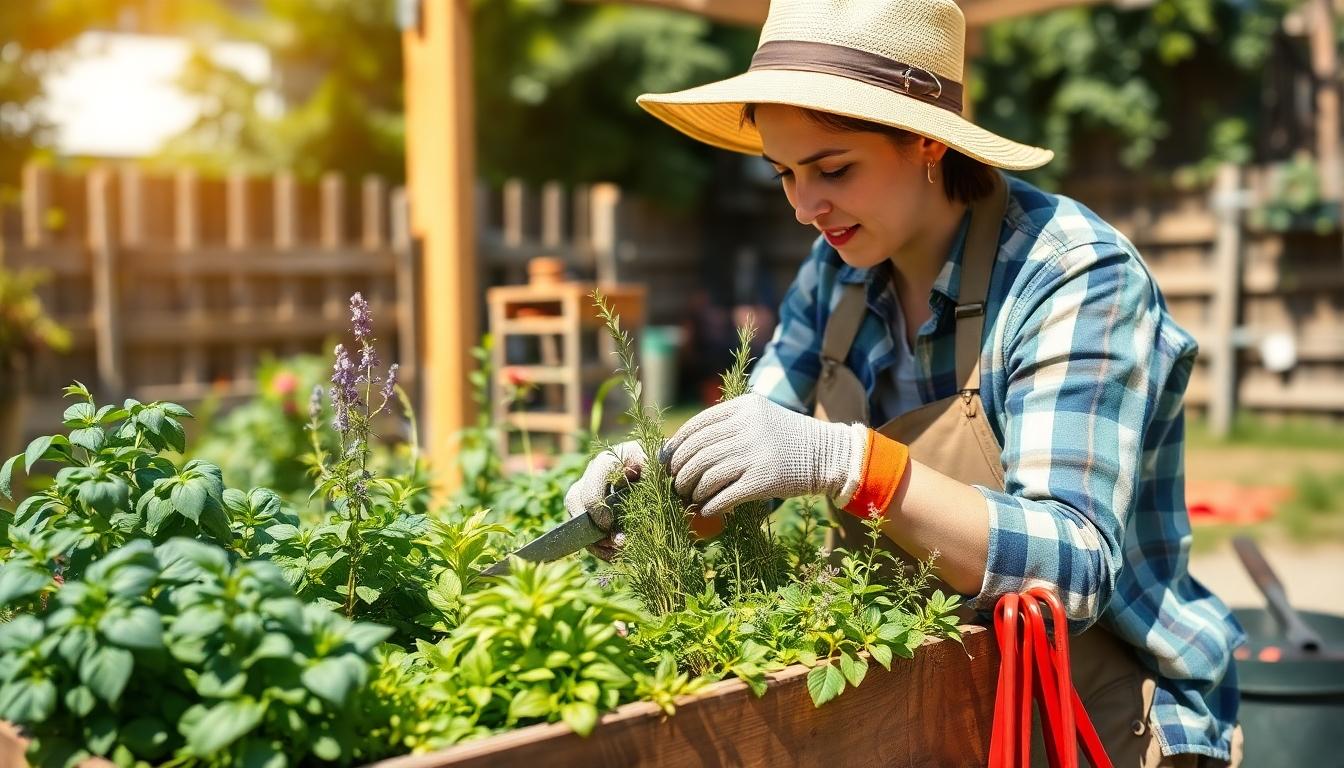
Knowing when and how to harvest your herbs ensures maximum flavor and extends your garden’s bounty year-round. We’ll explore the best techniques to cut, dry, and preserve your homegrown herbs for lasting enjoyment.
Proper Cutting Techniques
Using the right cutting methods keeps your plants productive and ensures the highest quality harvest. Clean pruners or scissors sanitized with rubbing alcohol prevent disease transfer between plants and promote healthy regrowth. Always cut herbs when their leaves are completely dry, ideally mid-morning after morning dew has evaporated, to reduce mold risk and significantly extend shelf life.
Follow the golden rule of herb harvesting by removing no more than one-third of a plant’s foliage weekly, which maintains healthy growth while providing regular harvests. For seed-bearing herbs like dill and fennel, allow the plants to mature fully until their seeds turn brown before collecting them using paper bags to catch any that fall during harvesting.
Drying and Freezing Methods
Drying preserves the concentrated flavors of woody herbs while freezing works best for delicate varieties. Air-drying works exceptionally well for sturdy herbs like rosemary and thyme – simply bundle them in small, loose clusters and hang upside-down in a warm, dark, well-ventilated area away from direct sunlight. Oven or dehydrator methods require low heat (95-115°F) to retain essential oils, especially for delicate herbs that might lose flavor at higher temperatures.
Store fully dried herbs in airtight glass containers away from light sources to maintain their potency for up to one year. Freezing offers an excellent alternative for delicate herbs like basil and cilantro that don’t dry well. Herb cubes made by chopping rinsed herbs and packing them into ice cube trays with water or oil create perfect portions for soups and sauces. Flash-freezing whole leaves on trays before transferring them to sealed bags prevents clumping and allows for easier portioning. Frozen herbs remain usable for 6-12 months, though they’ll lose their structural integrity when thawed.
Troubleshooting Common Herb Garden Problems
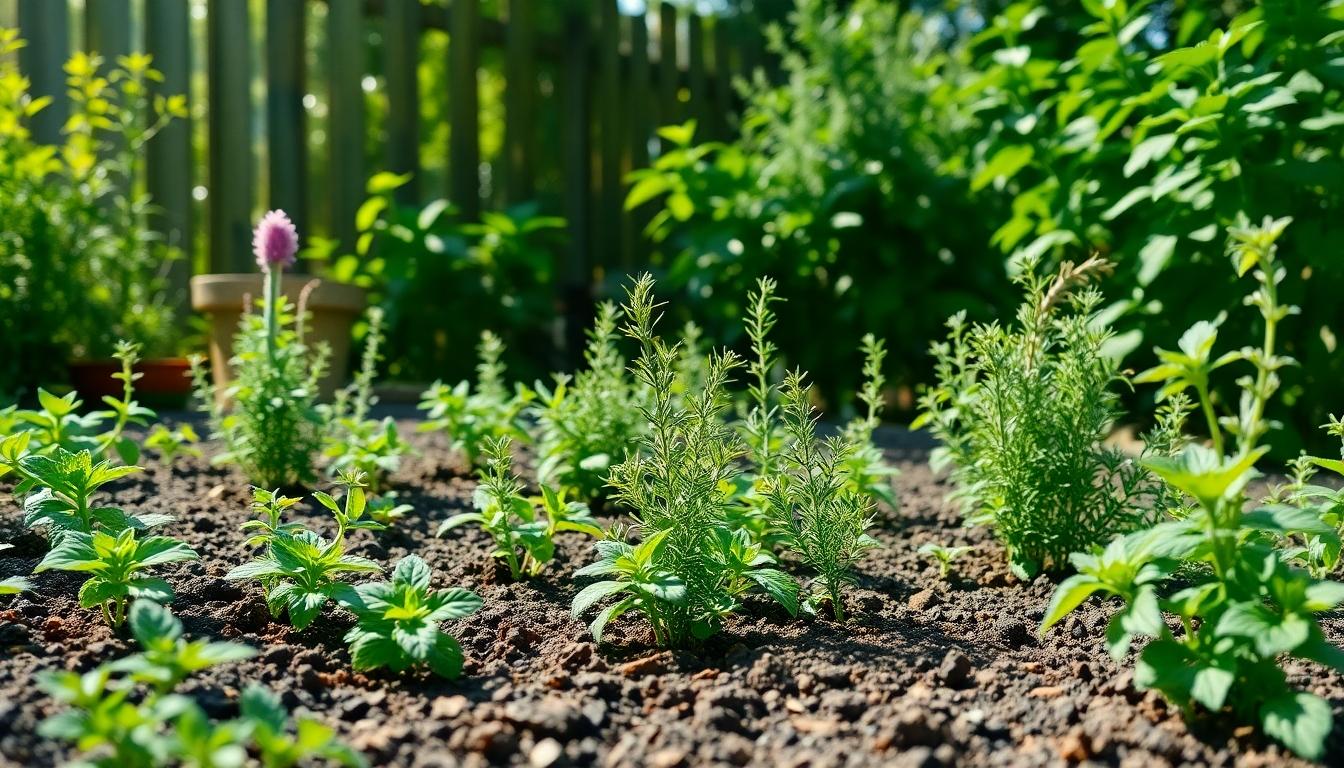
Even the most well-tended herb gardens face occasional challenges. Understanding how to identify and address common problems will keep your herbs thriving year-round.
Pest Management
Regular monitoring is essential for spotting aphids, spider mites, and whiteflies that frequently target herb gardens. These tiny pests can quickly multiply, so we recommend encouraging natural predators like ladybugs to keep populations in check naturally. For serious infestations, applying insecticidal soap offers an effective organic solution without harming your culinary herbs. Growing mint in containers not only prevents its invasive spread but also minimizes pest transfer between plants. Mulching around your herbs serves two purposes: deterring soil-dwelling pests while maintaining consistent soil moisture. Always check the undersides of leaves during your garden inspections, as this is where many pests first appear and establish colonies.
Disease Prevention and Treatment
Root rot frequently develops in herbs planted in waterlogged soil, making proper drainage absolutely critical. We’ve found that amending sandy soils with organic matter creates an ideal growing environment that maintains structure while ensuring excess water drains away quickly. Mildew and fungal diseases typically result from excessive moisture on foliage, particularly in densely planted areas. Watering at the soil level rather than over leaves helps prevent these issues, while strategic pruning of overcrowded growth improves critical air circulation. Prompt removal of any infected leaves stops disease spread, protecting your entire herb collection.
For optimal herb garden health, carry out these key preventative practices:
- Use quality soil that’s nutrient-rich and well-aerated, avoiding depleted growing mediums that lack essential nutrients
- Prune regularly before flowering stages to direct energy toward foliage production rather than seed development
- Water wisely by checking soil moisture about 2 inches deep and only irrigating when this layer feels dry
- Space plants properly to reduce humidity between herbs and minimize disease pressure
Selecting disease-resistant herb varieties gives your garden a strong foundation against common problems. Mediterranean herbs like rosemary and thyme require full sun exposure to develop proper oil content and disease resistance. Indoor herb gardens need 6-8 hours of daily light and protection from cool drafts that can stress plants and make them more susceptible to problems.
Conclusion: Enjoying the Rewards of Your Herb Garden
Starting your own herb garden opens a industry of culinary possibilities and sensory pleasures right at your fingertips. With just a few containers soil and seeds you’ll transform ordinary meals into extraordinary experiences.
The journey from planting to harvesting brings immense satisfaction whether you’re snipping fresh basil for pasta or adding mint to summer drinks. Even in small spaces these versatile plants thrive with minimal care while delivering maximum flavor.
We hope this guide has inspired you to begin your herb gardening adventure. Remember that each herb harvested represents not just a flavorful addition to your cooking but a step toward more sustainable and connected living. Your herb garden awaits – it’s time to get growing!
Frequently Asked Questions
What are the benefits of growing my own herb garden?
Growing your own herb garden provides fresher meals with vibrant flavors, aromatherapy benefits from fragrant plants, and contributes to sustainable living. It’s rewarding regardless of your living space size, offering quick results as most herbs grow rapidly with minimal maintenance while providing months of harvests for your cooking needs.
Which herbs are best for beginners to grow?
The seven best herbs for beginners are basil, rosemary, mint, parsley, thyme, chives, and cilantro. These herbs offer a range of flavors, are relatively easy to maintain, and provide versatility in cooking. Basil and cilantro are perfect annuals, while rosemary, mint, thyme, and chives return year after year as perennials.
How much sunlight do herb gardens need?
Most herbs require 6-8 hours of sunlight daily for optimal growth. Full-sun lovers include basil, rosemary, thyme, and sage. Some herbs like mint, parsley, and cilantro can tolerate partial shade. For indoor gardens, place herbs near south or southwest-facing windows. Container gardening offers flexibility to move herbs to maximize sunlight exposure.
What type of containers work best for growing herbs?
Use containers made from natural, food-grade materials like cedar, untreated steel, or terra cotta. Ensure proper drainage with multiple holes at the bottom. Size requirements vary: small herbs like chives need 6-8 inch containers, medium herbs like basil require 8-10 inch pots, and larger herbs like rosemary thrive in 10-12 inch containers.
What kind of soil should I use for my herb garden?
Use a well-draining, nutrient-rich sandy-loam mixture. A good DIY blend combines equal parts compost, garden soil, and coarse sand with some perlite and organic fertilizer. Most herbs prefer slightly acidic to neutral pH (6.0-7.0). Organic amendments like compost and worm castings improve soil structure and fertility without harsh chemicals.
How often should I water my herb garden?
Water consistently but moderately, typically once or twice weekly when the top inch of soil feels dry. Container herbs may need daily watering during hot weather. Reduce watering in winter and increase during summer. Signs of overwatering include yellowing leaves and root rot, while underwatering shows as wilting and brown leaf tips.
How do I harvest herbs properly?
Harvest herbs in the morning using clean, sharp scissors or pruners. Never remove more than one-third of the plant at once. For leafy herbs like basil, pinch stems just above a leaf junction to encourage bushier growth. Harvest frequently to prevent flowering and maintain flavor, but allow plants to establish before first harvest.
How can I preserve my harvested herbs?
Air-dry woody herbs like rosemary and thyme by hanging small bundles upside down in a dark, well-ventilated area. Freeze delicate herbs like basil and cilantro in ice cube trays with water or olive oil. Store dried herbs in airtight containers away from heat and light. Properly preserved herbs can maintain good flavor for 6-12 months.
How do I prevent pests and diseases in my herb garden?
Regularly inspect plants for pests like aphids and spider mites. Use natural solutions such as insecticidal soap or neem oil for treatment. Prevent diseases by ensuring proper air circulation, avoiding overhead watering, using well-draining soil, and not overcrowding plants. Remove affected leaves promptly and consider companion planting to naturally deter pests.
Can I grow herbs indoors year-round?
Yes, herbs can thrive indoors year-round with proper conditions. Place them near south-facing windows or use grow lights for 6-8 hours daily. Choose compact varieties and drought-tolerant herbs like rosemary, thyme, and mint. Maintain higher humidity with pebble trays or occasional misting. Rotate plants regularly for even growth and pollinate flowering herbs manually if needed.

